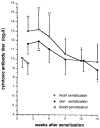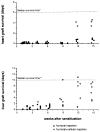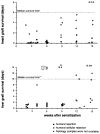Preformed lymphocytotoxic antibodies: the effects of class, titer and specificity on liver vs. heart allografts
- PMID: 1446895
- PMCID: PMC3005717
- DOI: 10.1002/hep.1840160618
Preformed lymphocytotoxic antibodies: the effects of class, titer and specificity on liver vs. heart allografts
Abstract
The effect on liver and heart allograft survival (ACI rats to Lewis rats) was studied after three methods of recipient presensitization and after different intervals between sensitization and transplantation. With comparable lymphocytotoxic antibody titers, liver allografts always survived longer than heart grafts. The titer, class and specificity of the antibodies varied with the method of sensitization. Four skin grafts produced IgG and IgM lymphocytotoxic antibody titers of 1:2,000 to 4,000. The IgG fraction was shown to have hepatic vascular endothelial specificity by indirect immunofluorescence. These primed recipients hyperacutely rejected both heart and liver allografts, which showed vascular deposition of IgG antibodies. Survival of either kind of graft was inversely proportional to the lymphocytotoxic antibody titer and length of time after placement of the last skin graft. Presensitization with a single heterotopic heart graft produced an even higher mixed IgG and IgM lymphocytotoxic antibody titer of 1:8,000 but with less IgG vascular endothelial specificity. These animals also hyperacutely rejected heart or liver grafts with tissue deposition of IgG but less consistently and with a weaker correlation with lymphocytotoxic antibody titers and time after sensitization. Sensitization with two pretransplant blood transfusions produced the lowest titer (1:500 to 1,000) and the least IgG vascular endothelial specificity. Liver allograft survival was routinely enhanced in these animals, and little effect was seen on heart grafts. Collectively, the experiments showed that the liver is not only resistant to antibody-mediated rejection relative to the heart but is more easily enhanced.(ABSTRACT TRUNCATED AT 250 WORDS)
Figures





References
-
- Terasaki PI, Marchioro TL, Starzl TE. Sero-typing of human lymphocyte antigens: preliminary trials on long-term kidney homograft survivors. Conference and workshop on histocompatibility testing; Washington DC: National Academy of Sciences, National Research Council; 1965. pp. 83–96.
-
- Kissmeyer-Neilsen F, Olsen S, Peterson VP, Fjeldborg O. Hyper-acute rejection of kidney allografts, associated with pre-existing humoral antibodies against donor cells. Lancet. 1966;2:662–665. - PubMed
-
- Gubernatis G, Lauchart W, Jonker M, Steinhoff G, Bornscheuer A, Neuhaus P, Van Es AA, et al. Signs of hyperacute rejection of liver grafts in rhesus monkeys after donor-specific presensitization. Transplant Proc. 1987;19:1082–1083. - PubMed
Publication types
MeSH terms
Substances
Grants and funding
LinkOut - more resources
Full Text Sources
Other Literature Sources
Medical
